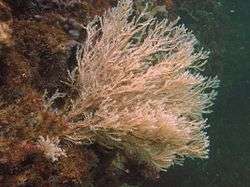Solanderia
Solanderia is the sole genus of hydrozoans in the monotypic family Solanderiidae.[1] They are commonly known as tree hydroids or sea fan hydroids.[2]
| Solanderia | |
|---|---|
| Grey fan hydroid (Solanderia procumbens) | |
| Scientific classification | |
| Kingdom: | Animalia |
| Phylum: | Cnidaria |
| Class: | Hydrozoa |
| Order: | Anthoathecata |
| Suborder: | Capitata |
| Family: | Solanderiidae Marshall, 1892[1] |
| Genus: | Solanderia Duchassaing & Michelin, 1846 |
| Species | |
|
See text | |
| Synonyms[1] | |
|
Family-level:
Genus-level:
| |
Description

Solanderia hydroids forms large colonies.They are one of about 1000 species of athecate hydroids, which do not construct a skeletal covering for their polyps (as opposed to the thecate hydroids in the order Leptothecata.[2] The chitinous skeleton is internal, branches, and may form anastomoses. The skeleton is formed by coalescence and modification of adjacent hydrocauline tubes. The coenosarc covers the entire colony and penetrates skeletal interstices. The hydranths cover the whole colony surface and are uniform in structure, cylindrical, with a single whorl of capitate tentacles around the mouth. Numerous similar tentacles are scattered over the body. Solanderia is known from its polyp or hydroid stage, and produces gonophores which release sperm and eggs for reproduction. Where known, the gonophores are cryptomedusoid or eumedusoid, arising directly from the coenosarc.[3]
Ecology
Species of Solanderia are eaten by nudibranchs in the genus Hermosita and the family Pleurolidiidae.[4]
Species

Solanderia contains the following species:[5]
- Solanderia dendritica (Fraser, 1938)
- Solanderia ericopsis (Carter, 1873)
- Solanderia fusca (Gray, 1868)
- Solanderia gracilis Duchassaing & Michelin, 1846
- Solanderia misakinensis (Inaba, 1892)
- Solanderia procumbens (Carter, 1873)
- Solanderia secunda (Inaba, 1892)
- Species brought into synonymy
- Solanderia atrorubens (Gray, 1868): synonym of Solanderia fusca (Gray, 1868)
- Solanderia minima (Hickson, 1903): synonym of Solanderia secunda (Inaba, 1892)
- Solanderia misakiensis (Inaba, 1892): synonym of Solanderia misakinensis (Inaba, 1892)
- Solanderia rufescens Jäderholm, 1896: synonym of Solanderia secunda (Inaba, 1892)
References
- Schuchert, P. (2015). Solanderiidae Marshall, 1892. In: Schuchert, P. (2015) World Hydrozoa database. Accessed through: World Register of Marine Species on 2015-12-17
- "Critter of the Week: Solanderia – the tree hydroid". NIWA. 2016. Retrieved 1 June 2016.
- Pallas, P.S. (1766) Elenchus zoophytorum. Van Cleef, Hagae-Comitum, pp. 1-451 IDDOC=222048 in Schuchert, P. (2013) World Hydrozoa database. Accessed through: World Register of Marine Species on 2013-08-12
- Carmona, L., Pola, M., Gosliner, T. M. & Cervera, J. L. (2015). Protaeolidiella atra Baba, 1955 versus Pleurolidia juliae Burn, 1966: One or two species? Helgoland Marine Research. doi:10.1007/s10152-014-0422-3
- Schuchert, P. (2015). Solanderia Duchassaing & Michelin, 1846. In: Schuchert, P. (2015) World Hydrozoa database. Accessed through: World Register of Marine Species on 2015-12-17